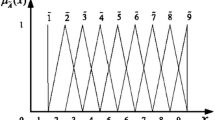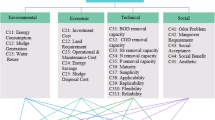Abstract
This work proposed a novel mathematical framework for the sustainability assessment of sewage sludge to energy (SStE) scenarios, by resorting to fuzzy multi-criteria decision-making (MCMD) methods. In which, an evaluation system including twelve criteria from four dimensions was introduced, while the fuzzy triangular number (TFN) was used to address the hybrid-data issue in the decision-making. More importantly, four fuzzy MCDM methods were used to make the following methodological contributions: (1) the fuzzy full consistency method (FUCOM) was extended into uncertain conditions to determine the weights easily and reliably, which preserves the consistency in ambiguous, subjective judgments; (2) a novel TFN-based fusion ranking model was developed by aggregating three fuzzy MCDM approaches, which not only takes the hybrid data as input information for decision-making (by combining the TFN) but also promotes the confidence in final prioritization (by reconciling different sequences). Four illustrative SStE scenarios were studied to test the feasibility of the model. Besides, the effectiveness and advantages of the model were verified by results comparison and discussion.








Similar content being viewed by others
Abbreviations
- AHP:
-
Analytic hierarchy process
- AD:
-
Anaerobic digestion
- BWM:
-
Best-worst method
- CINC:
-
Co-incineration in cement kilns
- DEMATEL:
-
Decision making trial and evaluation laboratory
- FUCOM:
-
Full consistency method
- GWP:
-
Global warming potential
- GRA:
-
Grey relation analysis
- LCA:
-
Life cycle assessment
- LCC:
-
Life cycle costing
- MCDM:
-
Multi-criteria decision-making
- PRSRV:
-
Projection ranking by similarity to referencing vector
- SCWO:
-
Supercritical water oxidation
- SCWG:
-
Supercritical water gasification
- SS:
-
Sewage sludge
- SStE:
-
Sewage sludge to energy
- SWM:
-
Sum weighted method
- TFN:
-
Triangular fuzzy number
- TOPSIS:
-
Technique for order of preference by similarity to ideal solution
- WWTPs:
-
Wastewater treatment plants
References
Adar E, Karatop B, Ince M, Bilgili MS (2016) Comparison of methods for sustainable energy management with sewage sludge in Turkey based on SWOT-FAHP analysis. Renew Sust Energ Rev 62:429–440
Agar DA, Kwapinska M, Leahy JJ (2018) Pyrolysis of wastewater sludge and composted organic fines from municipal solid waste: laboratory reactor characterisation and product distribution. Environ Sci Pollut Res 25:35874–35882
An D, ** BD, Ren JZ, Ren XS, Zhang WS, Wang Y, Dong LC (2018) Multi-criteria sustainability assessment of urban sludge treatment technologies: method and case study. Resour Conserv Recycl 128:546–554. https://doi.org/10.1016/j.resconrec.2016.08.018
Dong J, Chi Y, Tang Y, Wang F, Huang Q (2014) Combined life cycle environmental and exergetic assessment of four typical sewage sludge treatment techniques in China. Energy Fuel 28:2114–2122. https://doi.org/10.1021/ef4024146
Dursun M (2015) An integrated approach for the evaluation of wastewater treatment alternatives. World Congress Eng Comput Sci Wcecs Ii:1046–1051
Dusak V, Dmitrovic LG, Bagnall R (2017) Using AHP method for making a decision on how the management of sewage sludge in the northern Croatia. J Inf Organ Sci 41:161–170. https://doi.org/10.31341/Jios.41.2.2
Garrido-Baserba M, Molinos-Senante M, Abelleira-Pereira JM, Fdez-Guelfo LA, Poch M, Hernandez-Sancho F (2015) Selecting sewage sludge treatment alternatives in modern wastewater treatment plants using environmental decision support systems. J Clean Prod 107:410–419. https://doi.org/10.1016/j.jclepro.2014.11.021
Guan X, Sun GD, Yi X, Zhao J (2018) Grey relational analysis for hesitant fuzzy sets and its applications to multiattribute decision-making. Math Probl Eng
Guo S, Zhao HR (2017) Fuzzy best-worst multi-criteria decision-making method and its applications. Knowl-Based Syst 121:23–31
Hong JL, Hong JM, Otaki M, Jolliet O (2009) Environmental and economic life cycle assessment for sewage sludge treatment processes in Japan. Waste Manag 29:696–703
Kacprzak M, Neczaj E, Fijałkowski K, Grobelak A, Grosser A, Worwag M, Rorat A, Brattebo H, Almås Å, Singh BR (2017) Sewage sludge disposal strategies for sustainable development. Environ Res 156:39–46
Khoshand A, Rahimi K, Ehteshami M, Gharaei S (2019) Fuzzy AHP approach for prioritizing electronic waste management options: a case study of Tehran, Iran. Environ Sci Pollut Res 26:9649–9660
Lam C-M, Lee P-H, Hsu S-C (2016) Eco-efficiency analysis of sludge treatment scenarios in urban cities the case of Hong Kong. J Clean Prod:3028–3039. https://doi.org/10.1016/j.jclepro.2015.10.125
Laura F, Tamara A, Muller A, Hiroshan H, Christina D, Serena C (2020) Selecting sustainable sewage sludge reuse options through a systematic assessment framework: methodology and case study in Latin America. J Clean Prod 242:UNSP 118389. https://doi.org/10.1016/j.jclepro.2019.118389
Li H, ** C, Mundree S (2017a) Hybrid environmental and economic assessment of four approaches recovering energy from sludge with variant organic contents. J Clean Prod 153:131–138. https://doi.org/10.1016/j.jclepro.2017.03.167
Li H, ** C, Zhang ZY, O’Hara I, Mundree S (2017b) Environmental and economic life cycle assessment of energy recovery from sewage sludge through different anaerobic digestion pathways. Energy 126:649–657
Liu Y, Ren J, Man Y, Lin R, Lee CKM, Ji P (2020) Prioritization of sludge-to-energy technologies under multi-data condition based on multi-criteria decision-making analysis. J Clean Prod 123082
Lu F, Hua Z, Shao LM, He PJ (2018) Loop bioenergy production and carbon sequestration of polymeric waste by integrating biochemical and thermochemical conversion processes: a conceptual framework and recent advances. Renew Energy 124:202–211. https://doi.org/10.1016/j.renene.2017.10.084
Mills N, Pearce P, Farrow J, Thorpe RB, Kirkby NF (2014) Environmental & economic life cycle assessment of current & future sewage sludge to energy technologies. Waste Manag 34:185–195
Murray A, Horvath A, Nelson KL (2008) Hybrid life-cycle environmental and cost inventory of sewage sludge treatment and end-use scenarios: a case study from China. Environ Sci Technol 42:3163–3169
Pamucar D, Stevic Z, Sremac S (2018) A new model for determining weight coefficients of criteria in MCDM models: full consistency method (FUCOM). Symmetry-Basel 10
Pecchi M, Baratieri M (2019) Coupling anaerobic digestion with gasification, pyrolysis or hydrothermal carbonization: a review. Renew Sust Energ Rev 105:462–475. https://doi.org/10.1016/j.rser.2019.02.003
Peng Y, Kou G, Wang GX, Shi Y (2011) FAMCDM: a fusion approach of MCDM methods to rank multiclass classification algorithms. Omega Int J Manag S 39:677–689
Raheem A, Sikarwar VS, He J, Dastyar W, Dionysiou DD, Wang W, Zhao M (2018) Opportunities and challenges in sustainable treatment and resource reuse of sewage sludge: a review. Chem Eng J 337:616–641. https://doi.org/10.1016/j.cej.2017.12.149
Ren JZ, Liang HW, Chan FTS (2017a) Urban sewage sludge, sustainability, and transition for Eco-City: multi-criteria sustainability assessment of technologies based on best-worst method. Technol Forecast Soc 116:29–39. https://doi.org/10.1016/j.techfore.2016.10.070
Ren JZ, Liang HW, Dong L, Gao ZQ, He C, Pan M, Sun L (2017b) Sustainable development of sewage sludge-to-energy in China: barriers identification and technologies prioritization. Renew Sust Energ Rev 67:384–396. https://doi.org/10.1016/j.rser.2016.09.024
Suanon F, Chi Q, Yang X, Wang H, Rashid A, Asefi B, Mama D, Yu CP, Sun Q (2018) Diagnosis and ecotoxicological risk assessment of 49 elements in sludge from wastewater treatment plants of Chongqing and **amen cities, China. Environ Sci Pollut Res 25:29006–29016
Syed-Hassan SSA, Wang Y, Hu S, Su S, **ang J (2017) Thermochemical processing of sewage sludge to energy and fuel: fundamentals, challenges and considerations. Renew Sust Energ Rev 80:888–913. https://doi.org/10.1016/j.rser.2017.05.262
Tasabat SE (2019) A novel multicriteria decision-making method based on distance, similarity, and correlation: DSC TOPSIS. Math Probl Eng 2019:9125754. https://doi.org/10.1155/2019/9125754
Turunen V, Sorvari J, Mikola A (2018) A decision support tool for selecting the optimal sewage sludge treatment. Chemosphere 193:521–529. https://doi.org/10.1016/j.chemosphere.2017.11.052
Wang TC, Chang TH (2007) Application of TOPSIS in evaluating initial training aircraft under a fuzzy environment. Expert Syst Appl 33:870–880
Wu YN, Xu CB, Zhang T (2018) Evaluation of renewable power sources using a fuzzy MCDM based on cumulative prospect theory: a case in China. Energy 147:1227–1239
Xu D (2020) Sustainability prioritization of energy systems by develo** an integrated decision support framework with hybrid-data consideration. Sustain Energy Techn 39:UNSP 100719 https://doi.org/10.1016/j.seta.2020.100719
Xu D, Dong L (2019) Strategic diagnosis of China’s modern coal-to-chemical industry using an integrated SWOT-MCDM framework. Clean Technol Environ 21:517–532
Xu C, Lancaster J (2009) Treatment of secondary pulp and paper sludge for energy recovery. In: Edgard D, Arthur N (eds) Energy recovery, 1st edn. Nova Science Publishers, New York, pp 187–212
Xu CQ, Chen W, Hong JL (2014) Life-cycle environmental and economic assessment of sewage sludge treatment in China. J Clean Prod 67:79–87
Xu D, Lv LP, Dong LC, Ren JZ, He C, Manzardo A (2018a) Sustainability assessment framework for chemical processes selection under uncertainties: a vector-based algorithm coupled with multicriteria decision-making approaches. Ind Eng Chem Res 57:7999–8010
Xu D, Lv LP, Ren XS, Ren JZ, Dong LC (2018b) Route selection for low-carbon ammonia production: a sustainability prioritization framework based-on the combined weights and projection ranking by similarity to referencing vector method. J Clean Prod 193:263–276
Zhang YY, Li H (2019) Energy recovery from wastewater treatment plants through sludge anaerobic digestion: effect of low-organic-content sludge. Environ Sci Pollut Res 26:30544–30553
Zhang LH, Xu CB, Champagne P, Mabee W (2014) Overview of current biological and thermo-chemical treatment technologies for sustainable sludge management. Waste Manag Res 32:586–600
Funding
This research is supported by the Foundation of Chongqing Chemical Industry Vocational College (Grand No. HY2019-KJRC01), Science and Technology Research Program of Chongqing Municipal Education Commission (Grant No. KJQN201901512), Foundation of Chongqing University of Science & Technology (Grant No. 2019001), and National Natural Science Foundation of China (Grant No. 21776025).
Author information
Authors and Affiliations
Corresponding author
Ethics declarations
Conflict of interest
The authors declare that they have no conflict of interest.
Additional information
Responsible Editor: Ta Yeong Wu
Publisher’s note
Springer Nature remains neutral with regard to jurisdictional claims in published maps and institutional affiliations.
Electronic supplementary material
ESM 1
(DOCX 42 kb)
Rights and permissions
About this article
Cite this article
Tang, C., Xu, D. & Chen, N. Sustainability prioritization of sewage sludge to energy scenarios with hybrid-data consideration: a fuzzy decision-making framework based on full consistency method and fusion ranking model. Environ Sci Pollut Res 28, 5548–5565 (2021). https://doi.org/10.1007/s11356-020-10544-2
Received:
Accepted:
Published:
Issue Date:
DOI: https://doi.org/10.1007/s11356-020-10544-2




